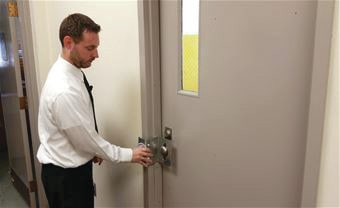
For Greene County News
FAIRBORN — Active shooter incidents across the United States seem to be occurring more and more often. Schools and military locations are not immune from such acts of violence.
These types of incidents have many people thinking about how they can be better prepared to react quickly in case something like an active shooter incident happens near them.
An Air Force Research Lab (AFRL) project team at Wright-Patterson Air Force Base has developed potentially life-saving portable door locks that could be easily placed on doors in a matter of seconds during an active shooter situation, thereby providing an extra level of security until first responders arrive at the scene to take control of the situation.
Researchers efforts were part of the 2015 AFRL Commanders Challenge held in June at the Muscatatuck Urban Training Center in Butlerville, Ind..
The team’s mission was to demonstrate new ways to deal with an active shooter scenario and each of the four teams competing was given six months and a limited budget to take their ideas from concept to an operational system that could be demonstrated for leaders across the Air Force and judges at the Commanders Challenge.
“We made a suite of four different locks that are intended to stop or deter active shooters in an emergency situation, so the whole concept is that the locks are portable, they are designed to be as light as possible, and infrastructure-free so doors or door frames don’t have to be modified,” Dr. John McIntire, an engineering research psychologist with AFRL’s 711th Human Performance Wing, said.
The locks are designed to be rapidly deployable in an emergency situation and easy to use by people under stressful conditions where mere seconds can save lives.
“In the stress of an emergency, we don’t want people to have to fiddle with a difficult contraption. We want them to be able to place the lock and be secure so they can take care of other responsibilities such as taking care of children, further barricading their areas, calling emergency services, etc.,” McIntire said.
According to McIntire, the team has done pretty intensive background research into the various facets of this problem to develop tech solutions for active shooter scenarios.
In fact, the locks were tested by teachers, administrators and security officers at both Northmoor Elementary School in Englewood and Northmont Middle School in Clayton earlier this spring. Teachers used the Z-shaped metal locks over classroom doorknobs during a safety drill, and according to Northmoor Principal Shannon Williamson, the teachers liked the locks and felt they were easy to use to keep the kids safe.
“We worked closely with both these schools to develop and test our systems, and receive actual user feedback from the teachers, staff and administrators, and then to use this information to iteratively improve upon our solutions. In both cases, police officers and school security officers from Englewood were involved as well. The teachers in particular were extremely excited about our tech, as well as being very helpful in giving feedback to us. As a thank you for their help, our team donated our demo locks to the Elementary School,” he said.
The four different types of locks the AFRL team designed are currently in a transition program with patents pending to see if there may be commercial interest in them.
They could be made commercially available for schools, office buildings, business travelers, especially those whose work takes them oversees to locations where security may be an issue, or just to people living by themselves who might like an extra layer of security for their doors at home.


